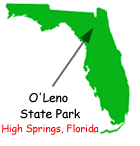
Reservations for
Florida State
Parks are now
made through
Reserve America,
toll free, at
1-800-326-3521
|
O'LENO
STATE PARK
 O'Leno State Park is located on the banks of the scenic and unique Santa
Fe River, a tributary of the Suwannee River. Within the park, the Santa
Fe disappears and flows underground for more than three miles before it
again becomes a surface stream, spotlighting the geological distinction
of the park. Including the adjacent preserve, the park encompasses in
excess of 6,000 acres in Alachua and Columbia Counties. O'Leno State Park is located on the banks of the scenic and unique Santa
Fe River, a tributary of the Suwannee River. Within the park, the Santa
Fe disappears and flows underground for more than three miles before it
again becomes a surface stream, spotlighting the geological distinction
of the park. Including the adjacent preserve, the park encompasses in
excess of 6,000 acres in Alachua and Columbia Counties.
Other interesting features include sinkholes, hardwood hammock, river
swamp and sandhill communities commonly found in north central Florida.
HISTORY
In the mid-1800s, a town was founded upstream from where the river
disappears. Perhaps first known as Keno, after a game of chance, the settlement
was later called Leno. The town grew, and a mill, general store, hotel and
livery stable were built. Leno was the end of the line for the first telegraph
set up to link Florida with the outside world. When the railroad bypassed
the tiny town, Leno's decline was bound to occur. It took only until the
turn of the century for the settlement to become just a memory; the Old
Wire Road and mill dams are all that remain of this early lumber town.
The suspension bridge which spans the river was built by the Civilian
Conservation Corps (CCC) in the late 1930s. It still provides a pleasurable
view of the Santa Fe as well as one of the mill dams.
The park, acquired in the early 1930s, was developed by the CCC and the
Works Progress Authority (WPA) primarily for use as a summer forestry
camp and training facility.
ACTIVITIES
Within O'Leno, you will find ample opportunities for picnicking,
swimming, hiking, canoeing, fishing and trails for horseback riding.
If you're interested in camping, choices include family, primitive, youth
and group camping. The group camp accommodates up to 140 persons and includes
17 cabins, a dining hall, meeting building and pavilion. The kitchen
is fully equipped with utensils, dishes and flatware. Cabins are furnished
with cots and mattresses. Guests must provide their own towels, pillows
and bed linens. The youth tent camping area is for organized, non-profit
youth groups. Special restrictions and fees apply. Family camping includes
a total of 64 sites in the Dogwood Magnolia camping loops. Water and electricity
are available. Campfire programs and guided walks are provided seasonally.
A refreshing swim is a favorite way to enjoy the Santa Fe River. Also
explore the river by canoe and observe the area's scenic beauty and wildlife.
Canoe rentals are available at the park.
O'Leno has two scenic nature trails. The Santa Fe River Trail takes you
along the river to the "river sink" where the river disappears underground. Alligators and turtles are sometimes seen. The Limestone
Trail passes through a hardwood hammock, past a limestone outcrop and
then by a pine forest.
The Santa Fe River is an unpredictable fishing spot. Sometimes the fish
bite, sometimes they don't. A Florida freshwater fishing license is required
for anyone 16 years of age or older who wants to cast a line for bass,
bream or catfish.
A WORD ABOUT ALLIGATORS
Although they appear tame, they are dangerous animals and should not be
approached, teased or frightened. Feeding alligators is dangerous and is
a violation of park regulations and state law. Dependence on unnatural foods
makes alligators lose their fear of man and may make them easy prey for
poachers. If you enjoy seeing alligators in the park, don't feed them.

O'Leno State Park is located on U.S. 441, six miles north of High Springs.
For information, contact:
O'Leno State Park
Route 2, Box 1010
High Springs, Florida 32643
(386)454-1853
View Larger Map |
|




 O'Leno State Park is located on the banks of the scenic and unique Santa
Fe River, a tributary of the Suwannee River. Within the park, the Santa
Fe disappears and flows underground for more than three miles before it
again becomes a surface stream, spotlighting the geological distinction
of the park. Including the adjacent preserve, the park encompasses in
excess of 6,000 acres in Alachua and Columbia Counties.
O'Leno State Park is located on the banks of the scenic and unique Santa
Fe River, a tributary of the Suwannee River. Within the park, the Santa
Fe disappears and flows underground for more than three miles before it
again becomes a surface stream, spotlighting the geological distinction
of the park. Including the adjacent preserve, the park encompasses in
excess of 6,000 acres in Alachua and Columbia Counties.
